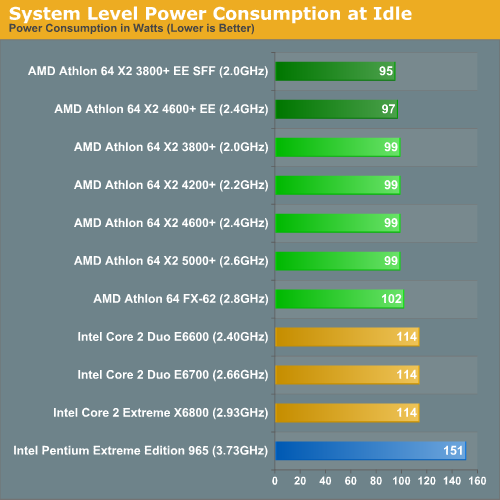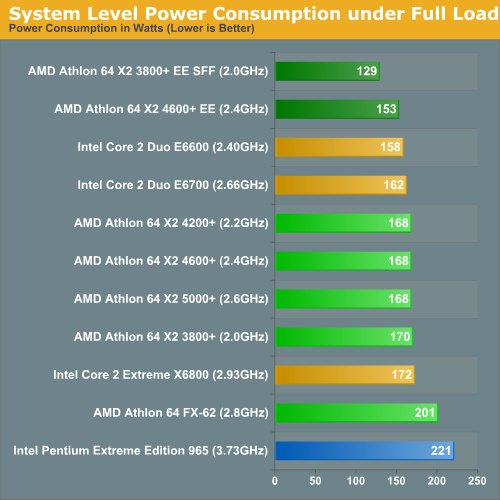Intel's Core 2 Extreme & Core 2 Duo: The Empire Strikes Back
by Anand Lal Shimpi on July 14, 2006 12:00 AM EST- Posted in
- CPUs
Power Consumption: Who is the king?
Intel promised us better performance per watt, lower energy consumed per instruction, and an overall serious reduction in power consumption with Conroe and its Core 2 line of processors. Compared to its NetBurst predecessors, the Core 2 lineup consumes significantly lower power - but what about compared to AMD?
This is one area that AMD is not standing still in, and just days before Intel's launch AMD managed to get us a couple of its long awaited Energy Efficient Athlon 64 X2 processors that are manufactured to target much lower TDPs than its other X2 processors. AMD sent us its Athlon 64 X2 4600+ Energy Efficient processor which carries a 65W TDP compared to 89W for the regular 4600+. The more interesting CPU is its Athlon 64 X2 3800+ Energy Efficient Small Form Factor CPU, which features an extremely low 35W rating. We've also included the 89W Athlon 64 X2s in this comparison, as well as the 125W Athlon 64 FX-62.
Cool 'n Quiet and EIST were enabled for AMD and Intel platforms respectively; power consumption was measured at the wall outlet. We used an ASUS M2NPV-VM for our AM2 platform and ASUS' P5W DH Deluxe for our Core 2 platform, but remember that power consumption will be higher with a SLI chipset on either platform. We used a single GeForce 7900 GTX, but since our power consumption tests were all done at the Windows desktop 3D performance/power consumption never came into play.
We took two power measurements: peak at idle and peak under load while performing our Windows Media Encoder 9 test.

Taking into consideration the fact that we were unable to compare two more similar chipsets (we will take a look back at that once retail Intel nForce 5 products hit the shelves), these power numbers heavily favor Intel. The releative power savings over the Extreme Edition 965 show just how big the jump is, and the ~15% idle power advantage our lower power AMD motherboard has over the Intel solution isn't a huge issue, especially when considering the performance advantage for the realtively small power investment.

When looking at load power, we can very clearly see that AMD is no longer the performance per watt king. While the Energy Efficient (EE) line of X2 processors is clearly very good at dropping load power (especially in the case of the 3800+), not even these chips can compete with the efficiency of the Core 2 line while encoding with WME9. The bottom line is that Intel just gets it done faster while pulling fewer watts (e.g. Performance/Watt on the X6800 is 0.3575 vs. 0.2757 on the X2 3800+ EE SFF).
In fact, in a complete turn around from what we've seen in the past, the highest end Core 2 processor is actually the most efficient (performance per Watt) processor in the lineup for WME9. This time, those who take the plunge on a high priced processor will not be stuck with brute force and a huge electric bill.










202 Comments
View All Comments
Calin - Friday, July 14, 2006 - link
This is a bit more complicated - you could buy a $1000 FX-62, or you could buy a $316 Core2Duo, then a $150+ mainboard. If you want to run SLI, you are out of luck right now - but things might change in the immediate future. If you have NVidia SLI, you must go to Crossfire (at this moment).But anyway, looks like AMD can not compete in the top
Regs - Friday, July 14, 2006 - link
Since the P6!!!! Makes me think if AMD actually cares about improving performance on their processors. Maybe they should scrap the Fab in New York and make a research facility instead. Start hiring interns from MIT. Do something! lol.I admit, even though I enjoyed AMD having the performance crown, It was a period of limited choice and limited performance gain. Who here on the free market care about 100MHz increaments? They went from a 110nm to 90nm with no performance benifit - they went from single core to the dual core X2's with no performance benifit -- they went from DDR to DDR2 with no performance improvement -- now they are going to 65nm which they also made clear they will make no changes to increase performance. AMD has really dropped the ball and they deserve what they get. I don't know why anyone, including over clockers, would want to be a AMD fan boy at the momment.
CKDragon - Friday, July 14, 2006 - link
AMD went from single core to dual core with no performance benefit?Maybe on Planet Troll...
Regs - Friday, July 14, 2006 - link
The X2 improved performance only on specific suites of software. Can you say the same about Conroe? I mean I was really able to crank up the rez in oblivion after I upgraded to an X2 *rolls eyes*.JarredWalton - Friday, July 14, 2006 - link
The performance increases you're seeing in most games on Core 2 Duo come entirely from the better architecture, not from dual processor cores. We just can't test single core performance on Core 2 because such chips don't exist and they won't until Conroe-L ships (in about a year judging by road maps -- it looks like Intel and their partners want to have time to clear out all of their NetBurst inventory first).Regs - Friday, July 14, 2006 - link
Yes, I completely agree. The only difference on the X2 compared to the single cores was encoding. Not unless you do own a 10-thousand dollar server for well...server use.Calin - Friday, July 14, 2006 - link
Being a fanboy is like a religion - you don't change your religion overnight.AMD cares about selling expensive processors. As long as the P4 was the opposition (especially after the Northwood days), AMD was king of hill, and sold its processors at whatever prices the market would pay. Now, Intel took that place. I hope this will change with K8L, as this will bring even lower prices for even better processors.
Also, AMD was unable to produce enough processors, so they sold most of it for a premium. As for the move to 90nm, they got some extra frequency headroom, and lower power consumption. This also reduced their costs (too bad the cost reduction wasn't really passed to customers).
If their move from single to dual core brought no performance benefit, tell that to companies buying dual core opterons for thousands dollars apiece.
segagenesis - Friday, July 14, 2006 - link
Good lord. You might as well throw up the GAME OVER and TILT signs for AMD right now. Although I wouldnt want them to disappear from competition (I dont want us to return to expensive Intel cpu's at the same time) there isnt much I see in this article that gives AMD any advantage at the moment over Intel. Sooner or later this was bound to happen from Intel though, the Athlon 64 made a similar situation against Pentium 4 making it look pretty obsolete comparitavely at the time.Now assuming the prices that AMD plans to drop to are correct, perhaps they can remain compeditive for building a budget system vs. Core 2 as I would not recommend a new Pentium 4 at this point to anyone...
That reminds me of the good ol days over overclocking the Celeron A...
dice1111 - Wednesday, July 19, 2006 - link
Ahhh, yes. My old Celeron A (still overclocked and in use). I was so happy about overclocking back then. Please Intel, let me get that taste of nostalgia!!!mobutu - Friday, July 14, 2006 - link
I'd really like to upgrade to Conroe but I don't want the Intel chipset on motherboard.Jarred, Wesley, do you know (estimate) when you'll have a review with final 590 reference board and when we can expect motherboards with 590 Intel edtn to be available?
Thanks in advance guys. Great Conroe review.